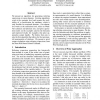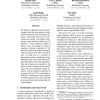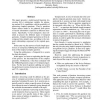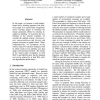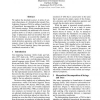109
Voted
ACL
2004
15 years 2 months ago
2004
Convolution kernels, such as sequence and tree kernels, are advantageous for both the concept and accuracy of many natural language processing (NLP) tasks. Experiments have, howev...
113
click to vote
ACL
2004
15 years 2 months ago
2004
We discuss Feature Latent Semantic Analysis (FLSA), an extension to Latent Semantic Analysis (LSA). LSA is a statistical method that is ordinarily trained on words only; FLSA adds...
111
Voted
ACL
2004
15 years 2 months ago
2004
Exploiting unannotated natural language data is hard largely because unsupervised parameter estimation is hard. We describe deterministic annealing (Rose et al., 1990) as an appea...
119
click to vote
ACL
2004
15 years 2 months ago
2004
We present an algorithm for generating referring expressions in open domains. Existing algorithms work at the semantic level and assume the availability of a classification for at...
ACL
2004
15 years 2 months ago
2004
We present an approach using syntactosemantic rules for the extraction of relational information from biomedical abstracts. The results show that by overcoming the hurdle of techn...
111
click to vote
ACL
2004
15 years 2 months ago
2004
This paper presents a multi-layered Question Answering (Q.A.) architecture suitable for enhancing current Q.A. capabilities with the possibility of processing complex questions. T...
ACL
2004
15 years 2 months ago
2004
In this paper, we propose a multi-criteriabased active learning approach and effectively apply it to named entity recognition. Active learning targets to minimize the human annota...
ACL
2004
15 years 2 months ago
2004
A crucial step toward the goal of automatic extraction of propositional information from natural language text is the identification of semantic relations between constituents in ...
ACL
2004
15 years 2 months ago
2004
We explore the descriptive power, in terms of syntactic phenomena, of a formalism that extends TreeAdjoining Grammar (TAG) by adding a fourth level of hierarchical decomposition t...
ACL
2004
15 years 2 months ago
2004

